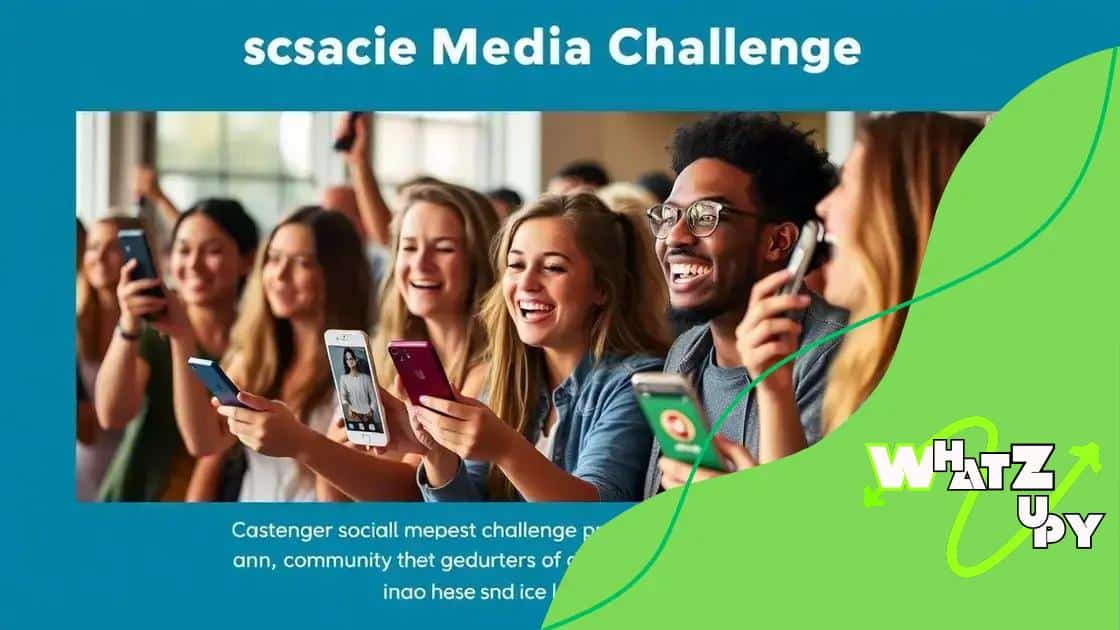Leveraging user-generated content to drive sales effectively

Leveraging user-generated content effectively drives sales by enhancing brand trust, increasing engagement, and showcasing authentic customer experiences, ultimately leading to higher conversion rates.
Leveraging user-generated content to drive sales is a powerful strategy that can transform your marketing approach. Have you ever considered how authentic testimonials and shared experiences can create a genuine connection with your audience?
Understanding user-generated content
Understanding user-generated content (UGC) is essential for businesses looking to connect with their audience in a meaningful way. This content, created by customers and fans, serves as authentic testimonials, allowing potential buyers to trust brands more.
UGC can take various forms, including reviews, photos, videos, and social media posts. Leveraging these materials not only boosts brand credibility but also enhances customer engagement.
Types of user-generated content
There are several types of user-generated content that brands can utilize to enhance their marketing efforts:
- Reviews: Customer opinions about products or services.
- Social media posts: Public shares of products, often tagged with brand hashtags.
- Photos and videos: Creative content made by users showcasing their experiences.
- Blog posts: Longer pieces written by customers sharing their stories and insights.
Each type of UGC provides valuable insights and fosters a sense of community among customers. By encouraging users to share their experiences, brands can create a vibrant ecosystem that attracts new customers. Engaging with UGC consistently shows that companies value their customers’ opinions.
Benefits of user-generated content
The advantages of incorporating user-generated content are profound. First, it significantly enhances brand trust. When potential customers see real users praising a product, they are more likely to convert.
Moreover, UGC is often more affordable than traditional marketing methods. Brands can save costs by promoting existing content instead of creating professional advertisements. This not only cuts costs but also provides a more personal touch to marketing campaigns.
Lastly, UGC boosts engagement by encouraging customers to share their thoughts and experiences, creating a two-way conversation. This interaction can lead to increased loyalty as customers feel valued and heard.
By integrating various types of UGC, brands can enhance their offerings and better connect with their customers. The world of user-generated content is an exciting opportunity that all businesses should explore.
Benefits of user-generated content for sales
The benefits of user-generated content for sales are substantial and can significantly impact a brand’s success. By tapping into the creativity of customers, brands can create authentic connections with their audience.
When customers share their experiences, it showcases genuine feedback that appeals to potential buyers. This authenticity boosts credibility and encourages trust. Customers are more likely to purchase from brands that have social proof provided by real users.
Enhanced customer trust
User-generated content plays a crucial role in building trust. Research shows that shoppers often rely on reviews from other customers before making a decision. These reviews offer insights that traditional advertising may not provide.
- Users appreciate seeing real-life examples of products.
- Testimonials from other customers often carry more weight than marketing claims.
- Trust in a brand increases when people see their peers endorsing it.
Moreover, user-generated content fosters a sense of community, making customers feel they are part of something larger. This inclusion leads to increased loyalty and repeat purchases. When customers feel connected, they are more likely to become brand advocates.
Cost-effectiveness
Creating user-generated content can be a cost-effective strategy for brands. Instead of investing heavily in professional advertising, companies can leverage existing content created by their customers. This not only saves money but also encourages a more authentic representation of the brand.
Additionally, UGC can extend the reach of marketing campaigns. When customers share their positive experiences on social media, they promote the brand further, often without any additional cost to the company.
In many cases, user-generated content leads to a higher return on investment (ROI). Brands can capitalize on the trust and authenticity that UGC brings, ultimately translating into higher sales.
How to encourage user-generated content

Encouraging user-generated content is essential for brands aiming to connect with their audience effectively. By inspiring customers to share their experiences, businesses can create a strong community and boost engagement.
One effective approach is to create a clear campaign or challenge that invites users to participate. This could involve asking customers to post their photos or reviews of a product using a specific hashtag. It allows brands to track the shared content easily while engaging customers across social media platforms.
Incentives and rewards
To motivate customers, consider offering incentives. A small reward, such as discounts or entry into a giveaway, can encourage more users to share their content. This strategy not only promotes participation but also shows customers that their contributions are valued.
- Offer exclusive discounts for shared content.
- Run a contest for the best user-generated photo.
- Highlight top contributors on your brand’s social media pages.
Promoting these rewards through your platforms can significantly increase the amount of UGC created. When customers see that their efforts are recognized, they are more likely to continue participating.
Make sharing easy
An essential part of encouraging user-generated content is simplifying the process. Providing clear instructions on how to share content can eliminate confusion. You can create templates or share guidelines about how customers can engage with your brand online.
Ensure that links to your social media and specific hashtags are easy to find. The more accessible you make it for customers to interact with your content, the more likely they are to engage. Brands should also create an appealing and user-friendly platform for showcasing this content.
Fostering relationships with customers is also key. Responding to comments and engaging with users can help create a supportive community around your brand. Show appreciation for user content by featuring their posts on your official channels.
Best platforms for sharing user-generated content
The best platforms for sharing user-generated content are crucial for brands looking to expand their reach and engage with customers effectively. By choosing the right platforms, businesses can capitalize on the creativity of their audience.
Popular social media sites like Instagram, Facebook, and Twitter provide excellent venues for users to share content. Each platform has unique features that can encourage user participation.
Instagram is one of the leading platforms for visual content, making it perfect for brands looking to highlight product photos, user stories, and creative posts. Brands can create eye-catching campaigns that encourage users to tag them in their photos, enhancing engagement.
- Use relevant hashtags to increase visibility.
- Promote engaging contests that require user participation.
- Feature user content on brand profiles to show appreciation.
These strategies help brands build a community around their products and promote authenticity.
Another strong contender is Facebook. This platform offers a diverse audience and various content sharing options, from videos to photo albums. Brands can host events or challenges that encourage users to contribute their content.
By creating a group specifically for customers to share their experiences, brands can foster a loyal community. Engaging with users through comments and shares can lead to increased brand loyalty.
Twitter is excellent for quick interactions and sharing thoughts. Users often post their experiences with products in real-time. Brands can engage with these tweets by liking, retweeting, or responding to them.
Utilizing specific hashtags related to campaigns can help make user-generated content more accessible, allowing for easy participation.
Ultimately, choosing the right platform is essential for effectively sharing user-generated content. By leveraging these platforms, brands can showcase their community, drive engagement, and enhance their reputation.
Measuring the impact of user-generated content
Measuring the impact of user-generated content is essential for understanding its effectiveness in driving sales and engagement. This process helps brands figure out what resonates with their audience and how UGC contributes to overall marketing strategies.
One of the most straightforward methods of measuring impact is through engagement metrics. Observing likes, shares, and comments on user-generated posts provides valuable insights into how audiences respond to this content. High engagement levels often indicate that the content is connected with viewers.
Website traffic and conversions
Another way to evaluate the effectiveness of user-generated content is by analyzing website traffic. Brands can use tools like Google Analytics to track visitors directed from UGC. If designed with clear calls to action, UGC can also show tangible results in conversion rates.
- Monitor referral traffic from social media posts.
- Assess how UGC impacts conversion rates on landing pages.
- Check the bounce rates of visitors coming from UGC links.
These insights help determine if UGC is successfully capturing customer interest and prompting purchase decisions.
Customer feedback and surveys
Directly gathering customer feedback can also be beneficial. Surveys asking customers about how user-generated content influenced their buying decisions provide quantitative data. By incorporating questions about their experience with UGC, brands can gain deeper insights into its effectiveness in shape customer perceptions.
Analyzing sentiment around user-generated content also gives brands valuable information. Positive sentiment is often linked to higher sales, while negative remarks can highlight areas for improvement.
Overall, measuring the impact of user-generated content is a vital step in understanding customer preferences and optimizing marketing strategies. By focusing on engagement metrics, conversion rates, and customer feedback, brands can enhance their use of UGC for better results in marketing campaigns.
FAQ – Frequently Asked Questions about User-Generated Content
What is user-generated content (UGC)?
User-generated content (UGC) refers to any content created by customers or fans, such as reviews, photos, and videos that showcase their experiences with a brand.
How can UGC benefit my business?
UGC can enhance brand trust, increase engagement, and drive sales by showcasing authentic customer experiences that resonate with potential buyers.
What platforms are best for sharing UGC?
Popular platforms include Instagram, Facebook, and Twitter, where users can easily share their content and interact with brands.
How can I measure the impact of UGC?
You can measure the impact of UGC by tracking engagement metrics, website traffic, conversion rates, and collecting customer feedback through surveys.





